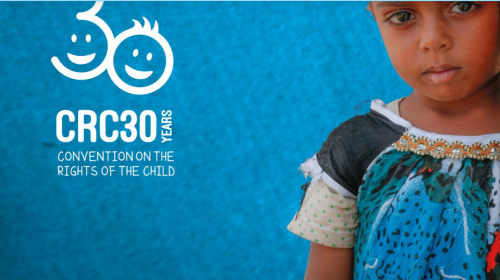
NEW YORK, 18 November 2019 –
Find the full report here: https://www.unicef.org/reports/convention-rights-child-crossroads-2019
https://www.unicef.org/press-releases/30-years-child-rights-historic-gai...
Part of commemorations marking the 30th anniversary of the CRC, the report looks at the undeniable achievements of the past three decades, proof that where there is political will and determination, children’s lives improve.
“There have been impressive gains for children over the past three decades, as more and more are living longer, better and healthier lives. However, the odds continue to be stacked against the poorest and most vulnerable,” said UNICEF Executive Director Henrietta Fore. “In addition to the persistent challenges of health, nutrition and education, children today have to contend with new threats like climate change, online abuse and cyberbullying. Only with innovation, new technologies, political will and increased resources will we help translate the vision of the Convention on the Rights of the Child into a reality for all children everywhere.”
Citing progress in child rights over the past three decades, the report notes that:
- The global under-five mortality rate has fallen by about 60 per cent.
- The proportion of primary-school-aged children not in school decreased from 18 per cent to 8 per cent.
- The guiding principles of the CRC – non-discrimination; the best interests of the child; the right to life, survival and development; and the right to participation – have influenced numerous constitutions, laws, policies and practices globally.
However, the report notes, this progress has not been even.
- In low and middle-income countries children from the poorest households are twice as likely to die from preventable causes before their fifth birthday than children from the richest households.
- According to recent available data, only half of children from the poorest households in sub-Saharan Africa are vaccinated against measles, compared to 85 per cent of children from the richest households.
- Despite a decline in child marriage rates globally, the poorest girls in some countries are more at risk today than they were in 1989.
The report also addresses age-old and new threats affecting children around the world:
- Poverty, discrimination and marginalization continue to leave millions of the most disadvantaged children at risk: Armed conflicts, rising xenophobia and the global migration and refugee crisis all have a devastating impact on global progress.
- Children are physically, physiologically and epidemiologically most at risk of the impacts of the climate crisis: Rapid changes in climate are spreading disease, increasing the intensity and frequency of extreme weather events, and creating food and water insecurity. Unless urgent action is taken, the worst for many children is yet to come.
- Although more children are immunized than ever before, a slowdown in immunisation coverage rates over the past decade is threatening to reverse hard-won gain in children’s health: Measles vaccination coverage has stagnated since 2010, contributing to a resurgence of the deadly disease in many countries. Almost 350,000 cases of measles were recorded in 2018, more than double the total in 2017.
- The number of out-of-school children has stagnated and learning outcomes for those in school remain poor: Globally, the number children who are not in primary level has remained static since 2007. Many of those who are in school are not learning the basics, let alone the skills they need to thrive in today’s economy.
To accelerate progress in advancing child rights, and to address stagnation and backsliding in some of these rights, the report calls for more data and evidence; scaling up proven solutions and interventions; expanding resources; involving young people in co-creating solutions; and applying the principles of equity and gender equality in programming. But it also recognizes that while all these elements are necessary to bring about change, our rapidly changing world also requires new modalities to confront emerging opportunities and challenges, and to truly embed the rights of children as a global cause again.
To find these pathways, over the next 12 months UNICEF plans to undertake a global dialogue on what it will take to make the promise of the convention a reality for every child. The discourse will be inclusive, involving children and young people, parents and caregivers, education and social workers, communities and governments, civil society, academia, the private sector and the media. And it will influence the way the organization does business in the future.
“The Convention stands at a crossroads between its illustrious past and its future potential. It is up to us to recommit, take decisive steps and hold ourselves accountable,” said Fore. “We should take our lead from young people who are speaking up and speaking out for their rights as never before, we must act now – boldly and creatively.”
###










Add new comment